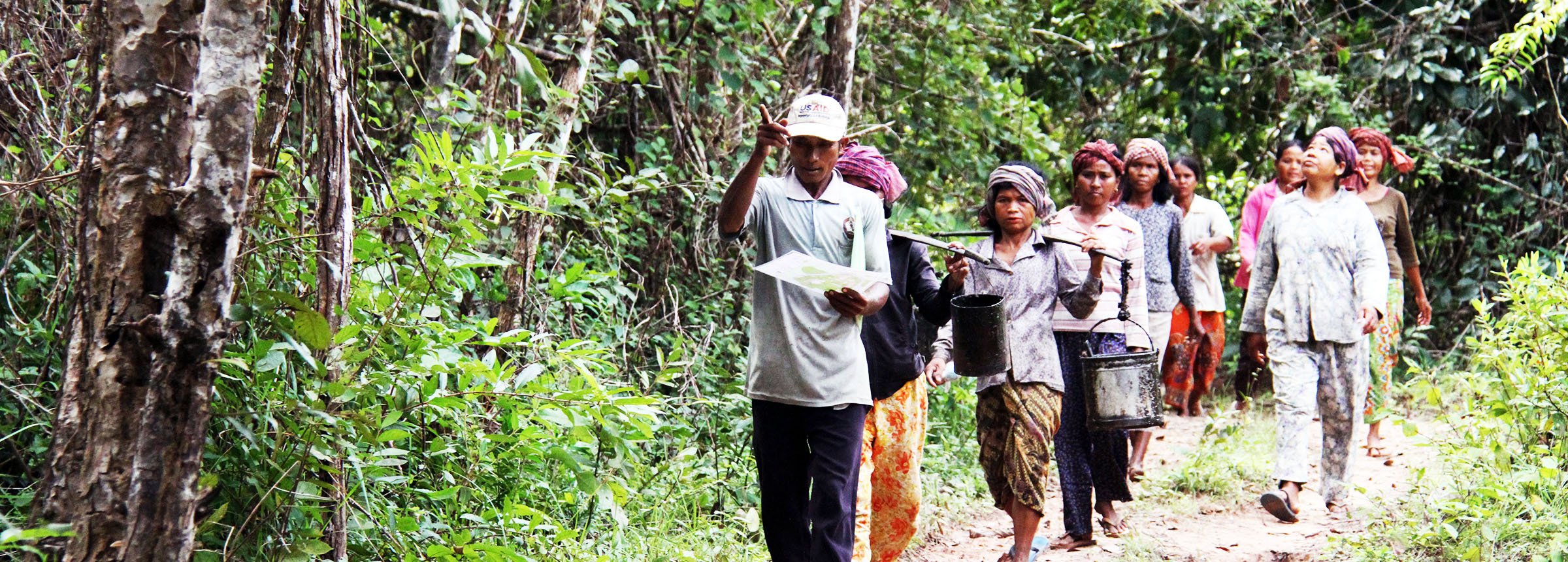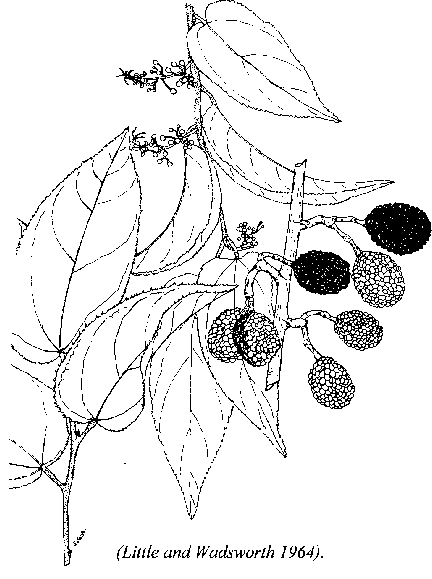
Guazuma ulmifolia: widely adapted tree for fodder and more
FACT 97-02, January 1997
A quick guide to multipurpose trees from around the world
A small to medium-sized tree, Guazuma ulmifolia is widely distributed throughout the Caribbean, Mexico, and Central and South America. The wood is used for posts, general carpentry, light construction and charcoal. It is an important source of livestock fodder in many areas, particularly during the dry season when pasture grasses are unavailable.
Common names include guácima, guácimo (Spanish); tablote, majagua de toro (Mexico); tapaculo (Guatemala, El Salvador); cualote (Guatemala, Honduras, El Salvador, Colombia); contamal (Guatemala); chicharrón (El Salvador); kamba aka guasa (Paraguay); iumanasi, papayillo (Peru); coco (Bolivia); cambá-acá, guazuma (Argentina); bacedar, bastard cedar (Jamaica, Trinidad); bois d’orme, West Indian Elm (Trinidad); pigeon wood (Tobago); bay cedar, caulote, pixoy (Belize);
bois d’orme, orme d’Amérique (French); mutamba, fruta-de-macaco, embira, pojó (Brazil) (Little and Wadsworth 1964, Lopez et al. 1987, Lorenzi 1992).
 Botany
Botany
Synonyms include Guazuma guazuma (L.) Cockerell, G. tomentosa H.B.K., G. polybotrya Cav., and Theobroma guazuma (L.) Poveda.
Guazuma ulmifolia Lam, family Sterculiaceae, grows to 30 m in height and 30-40 cm in diameter with a round-shaped crown. The alternate, ovate to lance-shaped leaves are 5-7 cm long and 2-5 cm wide, with finely saw-toothed margins. The flowers are brownish-yellow and form in clusters at the base of the leaves. The seeds are black, round to elliptic, 1.5-3 cm long, and hard. Seed capsules contain 5 cells which open at the apex and contain many seeds, 3-5 mm in diameter (Little and Wadsworth 1964, Lopez et al. 1987).
Young twigs are covered with rust-brown or light-gray star-shaped hairs. The bark is gray or gray-brown and becomes furrowed and rough or slightly shaggy (Little and Wadsworth 1964).
Ecology
Guazuma ulmifolia is widely adapted, growing in alluvial and clay soils, and in humid and dry climates. A pioneer species that grows best in full sunlight, it colonizes recently disturbed areas and is also found growing along stream banks and in pastures. It is a common species in secondary forest growth.
Guazuma ulmifolia grows mainly at elevations below 400 m with mean annual temperatures often above 24(C (Dunsdon et al. 1991). It is occasionally found growing up to 800 m in Brazil (Lorenzi 1992), 1000 m in Costa Rica (Vallejo and Oviedo 1994) and 1200 m in Guatemala (Witsberger et al. 1982). In its natural habitat annual rainfall is 600-1500 mm, but it grows well in areas with annual rainfall as high as 2500 mm (Dunsdon et al. 1991).
Leaves remain on the tree all year except in very dry areas where the leaves drop at the end of the dry season. In Puerto Rico, G. ulmifolia flowers from March to October and produces seed all year (Little and Wadsworth 1964). In Paraguay, it flowers in January and produces seed from July to August (Lopez et al. 1987). In Brazil, it flowers from January to September and produces seed in August and September (Lorenzi 1992).
Distribution
Guazuma ulmifolia is found in the Caribbean, Mexico, Central America and Colombia, Ecuador, Peru, Bolivia, Paraguay, Argentina, and Brazil. It has been cultivated in India for over 100 years. It has been introduced recently to Indonesia.
Uses
Wood. The wood is used for posts, interior carpentry, light construction, boxes and crates, shoe horns, tool handles, fuelwood, and charcoal. The sapwood is light brown and the heartwood is pinkish to brownish. The wood is easy to work, with a specific gravity of 550-570 km/m³ (Little and Wadsworth 1964,Lopez et al. 1987).
Fodder. In dry areas throughout its native range, G. ulmifolia is an important source of fodder for livestock, particularly at the end of the dry season when pasture grasses are not available. Naturally regenerated trees are left scattered in pastures to provide shade. Trees are also planted as live posts for fences around pastures. In Puerto Rico, immature fruits and leaves are fed to horses and cattle, and fruits are fed to hogs (Little and Wadsworth 1964). Guazuma ulmifolia is a preferred fodder tree in Jamaica. Farmers feed the leaves and fruit to cattle, usually during the dry season (Morrison et al. 1996). Crude protein content of young leaves and stems ranges from 16-23% and 7-8%, respectively. In vitro dry matter digestibility for young leaves and stems ranges from 56-58% and 31-36%, respectively (Araya et al. 1994, Medina et al. 1994). Basal leaves contain 2.4% tannins (dry matter) (Araya et al. 1994).
In a study in Honduras, G. ulmifolia pruned four times in one year produced 10 kg/tree dry matter (leaves and young stems). Of the dry matter, 38% was edible (Medina et al. 1994).
A study in Guatemala compared the weight gain of young goats fed fodder of G. ulmifolia, Cordia dentata, and Panicum maximum. The average weight gain with G. ulmifolia was 71 g/day, compared to60 g/day with C. dentata, and 42 g/day with P. maximum (Medina 1994).
Medicinal uses. A beverage of crushed seeds soaked in water is used to treat diarrhea, dysentery, colds, coughs, contusions, and venereal disease. It is also used as a diuretic and astringent (Vallejo and Oviedo 1994).
Other uses. The seeds are edible, fresh or cooked. The tough, fibrous bark and young stems are used to make rope and twine. Honey bees forage on the flowers (Little and Wadsworth 1964).
Silviculture
Propagation. Guazuma ulmifolia can be established by direct seeding or by planting cuttings, root-stumps or bare-root seedlings. Seeds require scarification before planting. Pour boiling water over seeds, let them soak for 30 seconds and then drain the water (Dunsdon et al. 1991). For fresh seeds, germination occurs in 7-14 days at a rate of 60-80%. Seedlings are ready for outplanting when they reach a height of 30-40 cm (about 15 weeks). For root stumps, plants are left in the nursery for 5-8 months or until they reach a stem diameter of 1.5-2.5 cm. There are between 100,000 and 225,000 seeds per kilogram (Vallejo and Oviedo 1994, Lorenzi 1992, Dunsdon et al. 1991).
Pests
Hilje et al. (1991) reviews pests of G. ulmifolia in Central America. Phelyypera distigma is a common defoliating insect. Arsenura armida and Epitragus sp. are defoliators that cause problems occasionally. Automeris rubrescens, Hylesia lineata, Lirimiris truncata and Periphoba arcaei are defoliating insects that have been observed at least once. A stem borer Aepytus sp. is an occasional problem.
References
Araya, J., J. Benavides, R. Arias, and A. Ruiz. 1994. Indentificación y caracterización de árboles y arbustos con potencial forrajero en Puriscal, Costa Rica. In: J. E. Benavides (ed), Arboles y arbustos forrajeros en América Central. Volumen 1. Serie Técnica, Informe Técnico N° 236. Centro Agronómico Tropical de Investigación y Ensenañza (CATIE).Turrialba,Costa Rica. p.31-63.
Dunsdon, A.J., J.L. Stewart, and C.E. Hughes. 1991. International trial of Central American dry zone hardwood species. Species descriptions and biomass tables. Oxford Forestry Institute. UK.
p. 39-41.
Hilje, L., C. Araya, and F. Scorza. 1991. Plagas y enfermedades forestales en América Central: guía de campo. Serie Técnica, Manual Técnico N°4., CATIE. Turrialba, Costa Rica. p. 185.
Little, E.L., and F.H. Wadsworth. 1964. Common trees of Puerto Rico and the Virgin Islands. Agricultural Handbook No. 249. USDA Forest Service. Washington, D.C., USA. p. 338-340.
Lopez, J.A., E.L. Little, G.F. Ritz, J.S. Rombold, and W.J. Hahn. 1987. Arboles comunes del Paraguay. Peace Corps. Washington, D.C., USA. p. 364-365.
Lorenzi, H. 1992. Árvores Brasileiras. Manual de identificação e cultivo de plantas arbóreas nativas do Brasil. Editora Plantarum LTDA. Nova Odessa, SP, Brasil. p. 327.
Medina, J.M. 1994. Observaciones sobre el consumo de follaje de Guácimo (Guazuma ulmifolia), Tiguilote (Cordia dentata), y Pasto Guinea (Panicum maximum) por cabras semi-estabuladas. In: Arboles y arbustos forrajeros en América Central. Volumen 1. p. 249-256. See
Araya et al. 1994.
Medina, J.M., B. Rouyer, M. Tejada, M. Layus, and B. Boiron. 1994. Evaluación preliminar de la producción de biomasa de especies leñosas bajo crecimiento natural en la zona Sur de Honduras. In:
Arboles y arbustos forrajeros en América Central. Volumen 1. p. 181-188. See Araya et al. 1994.
Morrison, B.J., M.A. Gold., and D.O. Lantagne. 1996. Incorporating indigenous knowledge of fodder trees into small-scale silvopastoral systems in Jamaica. Agroforestry Systems 34: 101-117.
Witsberger, D., D. Current, and E. Archer. 1982. Arboles del Parque Deininger. Dirección de Publicaciones, Ministerio de Educación. San Salvador, El Salvador. p. 248-249.
Vallejo, M.A., and F.J. Oveido. 1994. Características botánicas, usos y distribución de los principales árboles y arbustos con potencial forrajero de América Central. In: Arboles y arbustos
forrajeros en América Central. Volumen 2. Serie Técnica, Informe Técnico N° 236. Centro Agronómico Tropical de Investigación y Ensenañza (CATIE). Turrialba, Costa Rica. p. 676-677.
Written by Mark H. Powell, Winrock International
A publication of the Forest, Farm, and Community Tree Network (FACT Net)
